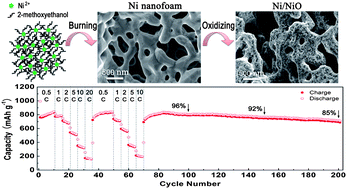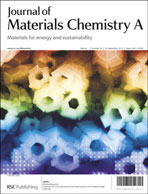3D interconnected network Ni nanofoams with large surface area were fabricated by a template-free approach. Their pore size and skeleton diameter are 150–350 nm and 200–300 nm, respectively. The homogeneous foaming structure and the metallic ductility of the Ni nanofoams make them suitable to be used as nanostructured current collectors. The Ni/NiO nanostructures were prepared by in situ thermal oxidation of the obtained Ni nanofoams. As anodes of lithium ion batteries, the Ni/NiO nanofoam electrodes deliver excellent cycling stability, superior rate capability, and high areal capacity. A high reversible capacity of 835 mA h g−1, which corresponds to an areal capacity of 2.1 mA h cm−2, was obtained after 200 cycles at a current rate of 0.5 C (1 C = 718 mA g−1). The Ni nanofoams exhibit an excellent electrochemical stability in electrolytes and are compatible with various electrochemically active materials as potential nanostructured current collectors for high-performance energy storage devices. Moreover, the preparation approach of the Ni nanofoams is facile, cost-effective, and can be used for large-scale production.

You have access to this article
 Please wait while we load your content...
Something went wrong. Try again?
Please wait while we load your content...
Something went wrong. Try again?


 Please wait while we load your content...
Please wait while we load your content...